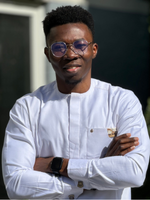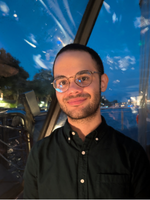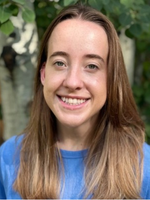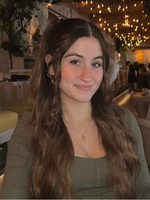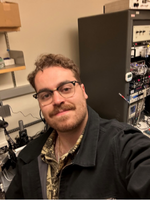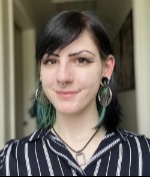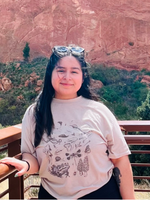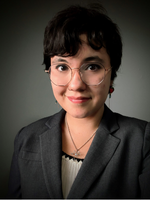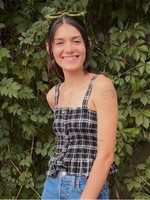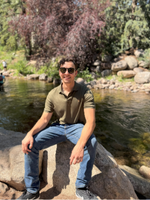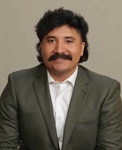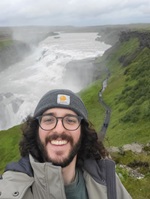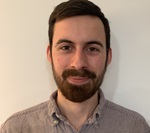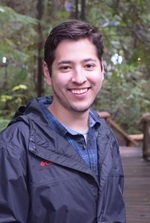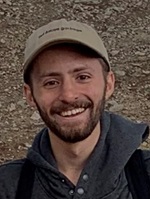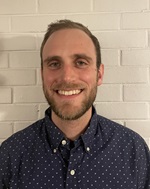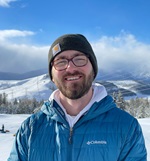GRADUATE STUDENTS
Students are the heartbeat of the Neuroscience program. With their energy, creativity and fearlessness, they drive cutting edge research in diverse labs across campus. They are close-knit and supportive through their successes and challenges. Students are highly motivated and compete exceptionally well for national fellowships from NIH and NSF. The program actively recruits minority students, and women make up over half the current student population.
Current Students
| Name | Matriculated | Mentor | Research |
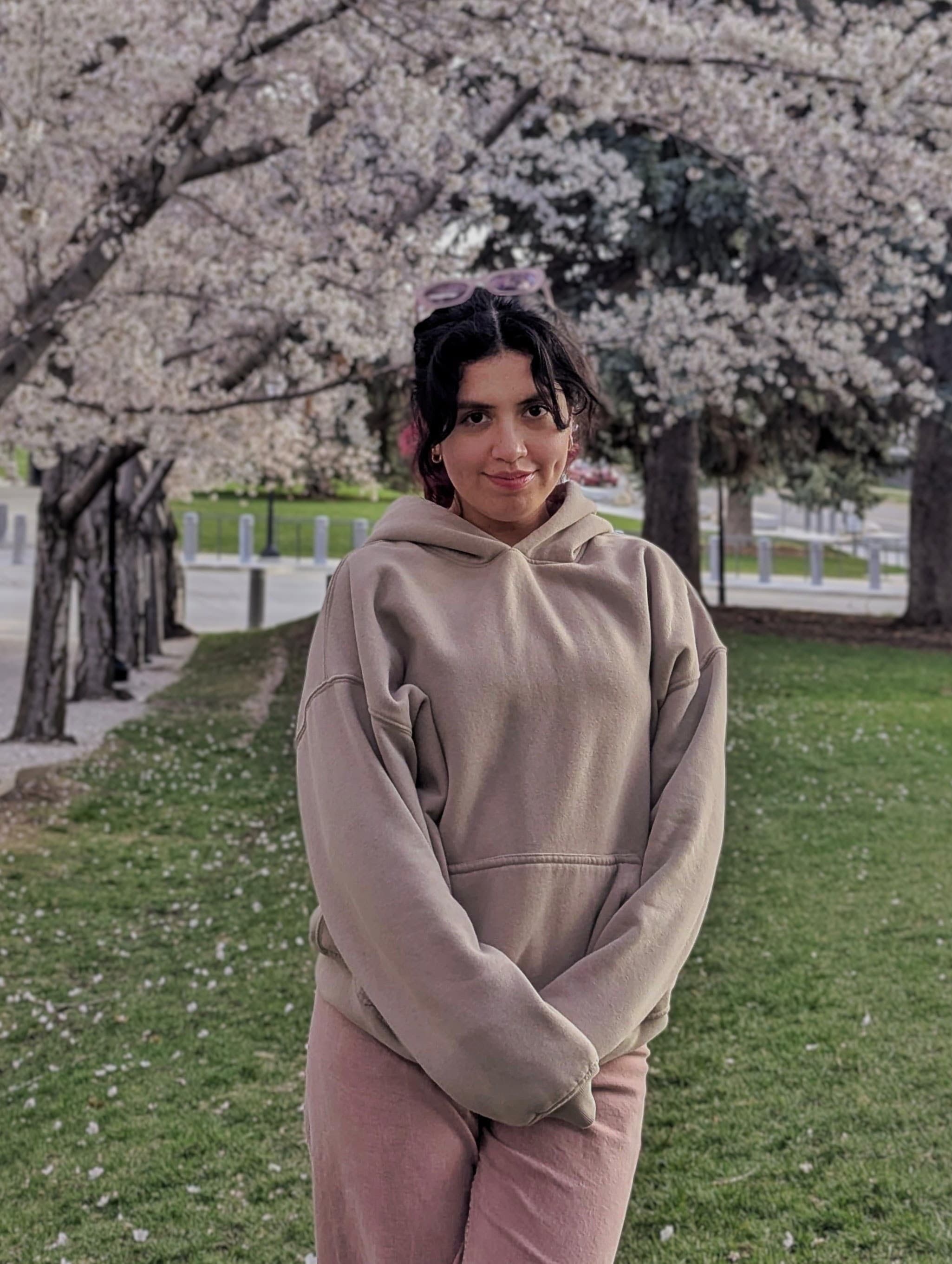 Yesica Landaverde Rodriguez | 2025 | Rotating | I am broadly interested in how glial cells communicate with neurons to shape neuronal circuits, both during development and disease. Yesica Landaverde Rodriguez ORCID |
Jude Abeje | 2025 | Rotating | I am interested in understanding how neuron-astrocyte interactions modulate synaptic vesicle cycle, synaptic plasticity, and synaptic defects in health and neurological disorders. Broadly, my interest spans understanding these mechanisms in neurodevelopment and neurodegeneration. |
Jenna Banh | 2025 | Rotating | I’m interested in the neural circuits underlying generating motor reflexes and how they are shaped by sensory input. I'm also interested in cellular and circuit-level contributors to neurodegenerative diseases. |
Joe Barreto | 2025 | Benjamin Scholl | I am broadly interested in visual neuroscience. My previous work focused on the function of visual circuits in mouse and ferret models using calcium imaging and behavioral methods. |
Elisabeth Harmon | 2025 | Rotating | I am interested in glial cell response to injury and disease. |
Tori Hoelscher | 2025 | Rotating | I am interested in investigating the cellular mechanisms underlying synaptic plasticity and how dysfunction in these mechanisms might contribute to neurological diseases and disorders. |
Lauren Immink | 2025 | Rotating | I am interested in studying neurodegenerative diseases, in particular, what happens when things go wrong. |
Ryan Lash | 2025 | Rotating | I’m broadly interested in systems and behavioral neuroscience. More specifically, what are the molecular mechanisms that govern neurodegenerative (i.e. Parkinson Disease) and psychiatric disorders(i.e. Addiction) and how might they be related? During my PhD, I hope to address these questions using a combination of biochemical and physiological approaches. |
Dani Preuschl | 2025 | rotating | My research interests include communication and neurodevelopmental disorders, specifically focusing on how challenges in social communication impact individuals with conditions such as ASD or various genetic disorders. I aim to investigate the underlying mechanisms contributing to these communication differences, and explore effective interventions to improve treatment outcomes. |
Natalie Preveza | 2025 | Rotating | Broadly, I’m interested in the role that synaptic plasticity plays within the processes of learning and memory. I am also interested in the molecular mechanisms involved in neurodevelopment, and how processes involved in neurodevelopment affect synaptic communication. |
Alyssa Romportl | 2025 | Rotating | I am interested in behavioral and cellular/molecular neuroscience in the context of mental illness and neurological diseases. |
Nicholas M. Senofsky | 2025 | Anthony Peng | I am broadly interested in experimental and computation hearing and balance biophysics. My current interests are examining how cranial nerve VIII efferent innervation and cAMP determine hair cell mechanotransduction sensitivity. |
Quinn Asbell | 2024 | Sardar | I am interested in astrocyte epigenetic changes in the olfactory system. My focus is on the alterations in astrocyte morhpology and it affect cell-cell interaction. |
 Anna Buteau | 2024 | Gidon Felsen | My current research aims to dissect the circuit that drives changes in visual perception during saccadic eye movements. We are focusing on a putative circuit in the superior colliculus, a visuomotor brain structure implicated in saccade generation and visual perception. |
Emily Dale | 2024 | Benjamin Scholl | My research interests broadly focus on naturalistic neurodevelopmental processes, and I am currently studying these processes within the context of structural and functional development of the visual cortex. |
Raquel Paz Zavala | 2024 | Stoddard | My current research focuses on how threat learning can be altered in adolescents with psychiatric disorders; specifically, on how this may aid in the development of individualized psychotherapy. |
Penelope Stuart-Hurtado | 2024 | Rotating | I am a first-year PhD student in neuroscience. My interest in human cognition and consciousness (and, by extension, how we learn and remember) had led me to focus upon the processes of LTP and LTD. I am currently rotating in labs investigating the molecular mechanisms underlying neuroplasticity and the role of proteins such as PKA and CaMKII in the LTP pathway. |
Bella Tyler | 2024 | Won Chan Oh | Broadly, my work in the Oh lab applies two-photon microscopy with optical and electrophysiological measurements to study the establishment of developing neural circuits, as well as their alterations in disease states. |
Miguel Yague | 2024 | Matt Kennedy | My research interests focus on elucidating the molecular mechanisms underlying brain plasticity, specifically the driving forces behind synaptic and myelin plasticity. |
Fan Yi Chao | 2023 | Ulli Bayer | I am interested in the molecular mechanisms of bi-directional synaptic plasticity that underlie cognition and strategies for restoring normal synaptic plasticity in neurological disorders. |
Elena Esch | 2023 (MSTP) | Alon Poleg-Polsky | Assessing the neurological and functional outcomes of eye transplantation including the survival and function of the retina post-transplantation, optic nerve regeneration, and whole-eye preservation. |
Kaylin Langer | 2023 (MSTP) | Quillinan | I study how neonatal hypoxic-ischemic brain injury may alter developmental synaptic pruning via the classical complement pathway. |
Kaitlyn Letourneau | 2023 | Person | I am investigating the cerebellar mechanisms underlying sensory processing and prediction deficits in autism spectrum disorder. I am using two mouse models, Fragile X Syndrome and Shank3, which are two of the most common syndromic forms of autism. I will be running a joystick pulling behavioral paradigm in conjunction with miniscope in vivo calcium imaging to look into how neural activity and behavioral adaptation are potentially altered following a sensory perturbation. |
Morgaine Goettl-Meyer Gyebison | 2023 | Peng | I am interested in auditory and vestibular hair cell physiology. |
Grant Hughes | 2023 | Christie | I am engaged in the study of systems neuroscience, with a specific emphasis on population-level neural dynamics. Through a combination of quantitative psychophysics, in vivo electrophysiology, and in vivo imaging, I aim to explore how populations of neurons compute and change behaviorally associated tasks, contributing to a profound understanding of sensory perceptions. |
Lauren Sarabia | 2023 | Legget | I am committed to pursuing a career in neuroscience research. More specifically, my primary goal is to become an independent principal investigator at an academic medical school. In terms of my research focus, I aim to use neuroimaging to better understand brain-behavior relationships, specifically those underlying the development of obesity in individuals with mental illness, who suffer from obesity at substantially higher rates than those observed in the general population. |

| 2023 | Patel | My current research aims at uncovering how neuronal reactive oxygen species can induce astrogliosis and if this can cause changes in astrocyte calcium and metabolism that may lead to hyperexcitability. |
Danae Mitchell | 2023 | Siegenthaler | Meningeal fibroblast regulation of brain development. Synaptic plasticity, developmental neuroscience, cellular and molecular neuroscience |
Salvador Guerra, Jr. | 2023 | Franco | My research interests are in formation and function of neural circuits, specifically in Cell-fate specification and patterning. I also have an interest in plasticity changes as it relates to cognitive and motor function following traumatic events. |
Michelle Near | 2023 | Christie | My primary research interest is in the area of biotechnology related to brain computer interfaces and optogenetics. Motor mechanisms and disease pathologies involved in many neurodegenerative disorders are still not properly understood. The development of neural prosthetics may act as a potential clinical solution and method for further understanding these disorders. |
Julia Lemak | 2023 | Person | My work explores how two major cerebellar cell types—Purkinje cells and cerebellar nuclei—work together to shape cerebellar output and drive online motor corrections. In particular, I am interested in how convergent input from multiple Purkinje cells shapes cerebellar nuclei firing during both execution of a learned behavior and in response to unexpected motor perturbations. To investigate these questions, I will use a variety of in vivo and ex vivo electrophysiology techniques, closed loop optogenetic stimulation, and forelimb reaching behavior assays. |
Victoria Chang | 2022 | Oh | My research is focused on exploring the cellular and molecular mechanisms by which the inhibitory 5-HT1A receptor modulates excitatory synapses in the developing prefrontal cortex |
Daphne Quang | 2022 | Potter | My research project aims to develop a platform to identify the molecular mechanisms underlying the contribution of APOE4 in Down syndrome-associated Alzheimer's disease (DS-AD) using human induced pluripotent stem cell-based microglia-containing cerebral organoids. In addition, I plan to test the efficacy of novel drugs identified in a screen for apoE4-Aβ inhibitors that may act on apoE4 derived from astrocytes and/or microglia to prevent or delay the onset of DS-AD. |
Crystal Minjarez | 2022 | Felson | I study the role of Pitx2 neurons in the superior colliculus and how they contribute to the circuitry underlying motor behavior, specifically saccadic eye movements. I use a combination of behavior, DREADDs, optogenetics, neurophysiology, and python coding analysis to address these questions. |
Jose Riguero | 2022 | Peng | I'm interested in studying mechanisms that underlie hearing loss at the level of mechanotransduction. I explore questions related to this subject through novel electrophysiological techniques that effectively stimulate outer hair cell bundles. |
Lisa Hirt | 2022 | Thompson | I am a computational neuroscientist that is interested in neuromoduluation and neuroimaging techniques in different clinical populations. My current research is focusing on the neural correlates of loss aversion in humans using stereotactic EEG. |
Joy Adler | 2022 | Chris Ford | I study how dopamine modulates glutamate receptor signaling in the nucleus accumbens and how this signaling is impacted in models of addiction. |
 Kristen Schuster | 2022 | Hughes | I am interested in elucidating the mechanisms that underlie activity-dependent myelin remodeling by combining in vivo 2-photon microscopy, behavioral assays, and molecular techniques. |
Paige Hoffman | 2022 | Alexander | I aim to determine the role increased axon growth plays in seizure generation for children with drug resistant epilepsy (DRE) from malformations of cortical development (MCDs). I am using a mouse model of focal cortical dysplasia (FCD) and an in-vitro model with induced pluripotent stem cell (IPSC) derived neurons from patients with tuberous sclerosis complex (TSC). |
Graham Peet | 2021 | Macklin | I study how autoantibodies affect the quality of remyelination after a demyelinating injury. This process is relevant to Multiple Sclerosis and other autoimmune demyelinating diseases. |
Luke Blecker | 2021 | Bankston/Proenza | Primarily interested in biophysics of ion channel and ionotropic receptors. In my thesis labs, I study the hyperpolarization activated cyclic nucleotide sensitive channel (HCN). I use a combination of whole cell and inside out patch clamp electrophysiology, molecular and cellular biology, and biochemistry to answer questions about this channel. |
Mayra Bueno Guerrero | 2021 | Dabertrand | My research focuses on understanding the mechanisms which cause deficits in neurovascular coupling in Alzheimer's Disease, and trying to restore neurovascular coupling in this disease model. |
Subash Lamichhane | 2021 | Christie | My research is focused on understanding the mechanism of endocannabinoid signaling in cerebellum learning. I use the bottom-up approach to study this mechanism. For my projects, I express biological sensors such as GRAB in cerebellar neurons to test their activities in response to endocannabinoid signaling and use pharmaceutical tools such as DART to manipulate their functioning from brain slices to live-behaving mice. |
Tessa Allen | 2021 | Macklin | My research focuses on oligodendrocyte dynamics in early development. |
Aleezah Balolia | 2021 (BSP) | Franco | |
Harrison James Ramsay | 2020 | Kennedy | My scientific interests pertain to the nanoscale organization of glutamatergic AMPARs, at the excitatory synapse. My recently published work highlights that these nanoscale receptor populations can form even at synapses where neurotransmission has been completely blocked throughout the life of the neuron. My current work investigates the effects of Alzheimer's relevant Amyloid-Beta on synaptic nanostructure. |
Kim Gagnon | 2020 | Welle | |
Luis Gomez Wulschner | 2020 | Oh | I'm interested in understanding how neuromodulators influence excitatory synapse maturation during early prefrontal cortex development. |
Matthew Larsen | 2020 | Bayer | I am interested in the mechanisms of excitatory synaptic plasticity underlying learning and memory. Specifically, I study the role of CaMKII in long-term potentiation, and how its functions are impaired in Alzheimer's disease and Down syndrome. |
Matthew Sergison | 2020 | Tollin | I study the effect of aging on binaural hearing. Specifically, I am interested in how aging leads to changes in the auditory brainstem that may underlie problems with spatial hearing. |
Becca Roth | 2020 | Bankston | I use whole-cell patch clamp electrophysiology and molecular dynamics simulations to determine the molecular mechanisms that control lipid-mediated potentiation of Acid-Sensing Ion Channels (ASICs). My project focuses on modeling interactions between ASIC3 and lipid mediators associated with inflammation and pain including Polyunsaturated Fatty Acids (PUFAs), N-acyl Amino Acids (NAAAs), and Lysphosphatidylcholines (LPCs). Additionally, I am also interested in understanding how these different classes of single chain lipids modulate the excitability of primary sensory neurons through ASIC3-dependent mechanisms. |
Sarah Wolfe | 2020 | Smith | I am interested in understanding synaptic changes during inhibitory synaptic plasticity. I want to understand the mechanisms regulating de novo protein synthesis during late stages of inhibitory long-term potentiation (iLTP). In particular, I am interested in the role of different transcription factors in regulating microRNA (miRNA) expression during iLTP. |
Jordan Hickman | 2020 | Denman | Electrical brain stimulation is a powerful clinical and research tool but how it affects neural activity and circuitry remains unclear. My project seeks to understand the neural response to electrical brain stimulation and its many parameters using high-density electrophysiological recordings in mice. The larger goal is that this may improve current uses of electrical brain stimulation and elucidate new uses. |
Jackson Stocking | 2020 (MSTP) | Person | My work explores cerebellar motor control of the mouse forelimb with the ultimate goal of laying the groundwork for a computational brain-computer interface to treat movement disorders. Towards this goal, I aim to map the outputs of the cerebellar nuclei to forelimb muscles and correct motor errors in an ataxia model with real-time optogenetic manipulation of the cerebellar nuclei. |
Courtney Dobrott | 2019 | Person | My thesis work in the lab of Dr. Abigail Person focuses on how output from the cerebellum contributes to the control of skilled movements such as reaching. Using a mouse model, my project aims to investigate the underlying cerebellar control policies that shape the production of skilled movements. Spanning circuit and behavioral levels, I will develop novel behavioral assays, conduct cell type specific recordings in the deep cerebellar nuclei, and utilize a closed loop kinematic system to alter reaching behavior through optogenetics. |
Michael Stockton | 2019 | Hughes | I use in vivo imaging (2-photon + 3-photon) to investigate the how oligodendrocyte precursor cells differentiate into myelinating oligodendrocytes in both health and disease. |
Natalie Carey | 2018 | Appel | I am interested in understanding the cellular and molecular mechanisms through which oligodendrocytes myelinate axons during development. |
Theresa Welle | 2018 | Smith | I study molecular mechanisms of inhibitory synaptic plasticity. My thesis work specifically focuses on the role of mRNA translation for supporting long-term changes in inhibitory synaptic strength. |
Juan Santiago-Moreno | 2018 | Denman | My project studies how the mouse visual system represents, transmits, and transforms information about color and form in the visual scene. Specifically, I am interested in how interactions between the lateral geniculate nucleus of the thalamus (LGN) and primary visual cortex (V1) represent color spatially, and how that information is propagated further up the visual system hierarchy. To investigate this, I perform awake electrophysiological recordings using multiple Neuropixels probes to capture the activity of hundreds of neurons simultaneously. |
Alumni
| Name | Graduated | Mentor | Current Position |
| Samuel Budoff | 2025 | Poleg-Polsky | |
| Ami Haas | 2025 | Quillinan | |
| Madisen Mason | 2025 | Franco | |
| Hannah Actor-Engel | 2024 | Kennedy | |
| Samantha Bromley-Coolidge | 2024 | Appel | |
| Christina Como | 2024 | Siegenthaler | |
| Rongchen Huang | 2024 | Welle | |
| Joshua Hunt | 2024 | Poleg-Polsky and Felson | |
| Jungmin Kim | 2024 | Aoto | |
| Keenan Kushner | 2024 | Huntsman | |
| Nickole Moon | 2024 | Bale | |
| Roberto Ogelman | 2024 | Oh | |
| Michael Thornton | 2024 | Hughes | |
| Jose Vigil | 2024 | Quillinan | |
| Katlin Zent | 2024 | Dell'Acqua | |
| Monica Benson | 2023 | Tollin | |
| Zoe Owrutsky | 2023 | Tollin | |
| Brigit High | 2023 | Finger | |
| Emma Boxer, PhD | 2022 | Aoto | |
| Myriam Moreno Garcia, PhD | 2022 | Quillinan | |
| Nicole Rumian, PhD | 2022 | Bayer | |
| Spencer Bowles, PhD | 2022 | Welle | |
| L. Dailey Nettles, PhD | 2022 | Welle | |
| Sarah Zych, PhD | 2022 | Ford | |
| Jesse Gilmer, PhD | 2022 | Person | |
| Dylan Calame, PhD | 2022 | Person | |
| Stephanie Garcia, PhD | 2022 | Freed | |
| Anand Tekriwal, PhD | 2022 | Felsen | |
| Dylan Verden, PhD | 2022 | Macklin | Research Engagement Director, KIF1A.ORG |
| Nicholas George, PhD | 2021 | Restrepo | Scientific Consultant, The BioTeam, Inc. |
| Karlie Fedder-Semmes, PhD | 2021 | Appel | Scientific Grant Writer, EpiCypher, Inc. |
| Francesca Manzella, PhD | 2021 | Todorovic | Postdoc, Washington University School of Medicine in St. Louis |
| Noah Goodson, PhD | 2020 | Brzezinski | Director, THREAD |
| Shelly Jones, PhD | 2020 | Schoppa | Juvenile Justice Resource Analyst, Colorado Department of Human Services |
| Matthew Becker, MD, PhD | 2020 | Person | Medical School (MD/PhD), University of Colorado Anschutz Medical Campus |
| Theodore Doykos, PhD | 2020 | Felsen | Postdoc, University of Colorado Anschutz Medical Campus |
| Alison Hixon, MD, PhD | 2019 | Tyler | Medical School (MD/PhD), University of Colorado Anschutz Medical Campus |
| Marisa Deguzman, PhD | 2019 | Frank | Medical Writer, Oxford PharmaGenesis |
| Eartha Guthman, PhD | 2019 | Huntsman | Postdoc, Princeton University |
| Julbert Caneus, PhD | 2018 | Potter | Scientist, Sanofi |
| Courtney Wilson, PhD | 2018 | Kinnamon | Postdoc, University of Colorado Anschutz Medical Campus |
| Christy Niemeyer, PhD | 2018 | Person | Postdoc, University of Colorado Anschutz Medical Campus |
| Alexander Ferber, MD, PhD | 2017 | Tollin | University of Colorado Anschutz Medical Campus |
| Kelsey Anbuhl, PhD | 2017 | Tollin | Postdoc, New York University |
| Andrew Bubak, PhD | 2017 | Swallow | Assistant Professor, Univeristy of Colorado Anschutz Medical Campus |
| Emily Sharpe, PhD | 2017 | Proenza | Engagement Manager, Trinity Life Sciences |
| Dayton Goodell, PhD | 2017 | Bayer | Postoc, University of Utah |
| Eamon Quick, PhD | 2017 | Tyler | Associate Tutor, Swell Education |
| Elizabeth Gould, PhD | 2017 | Restrepo | Postdoc, UT Health San Antonio |
| John Soltys, MD, PhD | 2016 | Bennett | Neurology Residency, University of South Alabama |
| Mario Lintz, MD, PhD | 2016 | Felsen | Psychiatry Residency, University of Colorado Anschutz Medical Campus |
| Christopher Knoeckel, MD, PhD | 2016 | Ribera | Instructor, Univeristy of Colorado Anschutz Medical Campus |
| Jason Smucny | 2016 | Tregellas | Assistant Professor, Univeristy of California Davis |
| Jennifer Pearson-Smith | 2016 | Patel | Scientific Program Manager, Taconic Biosciences |
| Jared Ahrendsen, MD, PhD | 2015 | Macklin | Resident, Beth Israel Deaconess Medical Center |
| Ajay Thomas, MD, PhD | 2015 | Brooks-Kayal | Baylor College of Medicine |
| Joseph Zak, PhD | 2015 | Schoppa | Assistant Professor, University of Illinois Chicago |
| Chelsea Corser-Jensen, PhD | 2015 | Heidenreich | Medical Science Liaison, Adamas Pharmaceuticals, Inc |
| Scott Goulding, PhD | 2015 | Caldwell | Senior Scientist, BioNTech S.S. |
| Vanessa Carmean, PhD | 2015 | Ribera | Chief Commercial Officer, Agathos |
| Tara Carlisle, MD, PhD | 2014 | Ribera | Neuropsychiatry Fellow, University of Colorado Anschutz Medical Campus |
| Pirooz Parsa, PhD | 2014 | Vijayaraghavan | Senior Neurology Regional Medical Liaison, Bristol Myers Squibb |
| Jonathan Murphy, PhD | 2014 | Dell'Acqua | Postdoc, Eunice Kennedy Shriver National Institute of Child Health and Human Development (NICHD) |
| Daniel Raible, PhD | 2014 | Brooks-Kayal | Field Technical Consultant, Medtronic |
| Jonathon Keeney, PhD | 2014 | Sikela | Assistant Professor, George Washington University |
| Pamela Lopert, PhD | 2014 | Patel | President, Clinical Research Consultant, PNL Clinical Science Consulting LLC |
| Emily Aurand, PhD | 2014 | Bjugstad | Director of Roadmapping and Education, Engineering Biology Research Consortium |
| Shane Rowley, PhD | 2014 | Patel | Senior Scientist, Recursion |
| Kathryn Bercury, PhD | 2014 | Macklin | Medical Science Liaison Lead, TG Therapeutics, Inc. |
| Cecil Saunders, PhD | 2013 | Finger | Assistant Professor, Wake Forest University |
| Kalen Dionne, MD, PhD | 2012 | Tyler | Instructor, Washington University in St. Louis |
| Jennifer Whitesell, PhD | 2012 | Schoppa | Associate Director, Cajal Neuroscience |
| Frances Meredith, PhD | 2012 | Rennie | Assistant Professor, University of Colorado Anschutz Medical Campus |
| Arisa Oshimoto, PhD | 2012 | Restrepo | |
| Jonah Scott-McKean, PhD | 2012 | Costa | Postdoc, Case Western Reserve University |
| Lisa Wilson, PhD | 2012 | Rojas | Owner, Skriv, LLC |
| Angela Rachubinski, PhD | 2011 | Bjugstad | Assistant Professor, University of Colorado Anschutz Medical Campus |
| Jennifer Thornton | 2011 | Tollin | |
| Heath Jones, PhD | 2011 | Tollin | Co-Founder, H Squared Capital, LLC |
| Nicole Gravagna, PhD | 2011 | Ribera | Senior Product Manager, Human Centered Design, interviewIA |
| Dianna Bartel, PhD | 2011 | Finger | Senior Scientific Account Director, Ashfield MedComms |
| Faye Doherty, PhD | 2011 | Sladek | IHC Director, Inotiv |
| Sruthi Thomas, MD, PhD | 2010 | Schoppa | Assisitant Professor, Baylor College of Medicine |
| Melissa Wright, MD, PhD | 2010 | Ribera | Assistant Professor, University of Colorado Anschutz Medical Campus |
| Joshua Ohrtman | 2010 | Beam | |
| Julie Milder, PhD | 2010 | Patel | US Medical Affairs Associate Director, Training and Excellence, Jazz Pharmaceuticals |
| Matthew Pink, PhD | 2010 | Dell'Acqua | Director, Business Developmen, Biodesix, Inc. |
| Eric Neeley, PhD | 2010 | Leonard | Senior Director, IQVIA |
| David Cantu, PhD | 2010 | Patel | Director, Medical Affairs, Sunovion Pharmaceuticals |
| Marc Yonkers, MD, PhD | 2009 | Ribera | Ocuplastic Surgeon, Kaiser Permanente |
| Santiago Farias, PhD | 2009 | Heidenreich | Senior Research Scientist, Gilead Sciences |
| Tianna Hicklin, PhD | 2009 | Browning | Assistant Editor, Science/AAAS Custom Publishing Office |
| Clint Perry, PhD | 2009 | Grichtchenko | |
| David Gire, PhD | 2009 | Schoppa | Assistant Professor, University of Washington |
| Monique Beaudoin, PhD | 2009 | Krushel | Associate Research Scientist, University of Maryland Applied Research Laboratory for Intelligence and Security |
| Danielle Harlow, PhD | 2009 | Barlow | Senior Medical Director, EMD Serono, Inc. |
| Wilder Doucette, PhD | 2008 | Restrepo | Assistant Professor, Dartmouth |
| Seth Oliveria, MD, PhD | 2008 | Sather | Neurosurgeon, The Oregon Clinic |
| Sarah Stephens, PhD | 2008 | Leonard | |
| Christy Rossi, PhD | 2008 | Artinger | Associate Professor, University of Denver |
| Angela Tollefson | 2007 | Tyler | |
| Brian Gulbransen, PhD | 2007 | Finger | Associate Professor, Michigan State University |
| Michael Gaffield, PhD | 2007 | Betz | Research Fellow, Max Planck Florida Institute for Neuroscience |
| Susan Goody, PhD | 2007 | Browning | Senior Director, Head of Toxicology, Moderna |
| Liam Breeze, PhD | 2006 | Sather | Technical Sales Representative, Molecular Devices |
| Dan Sdrulla, MD, PhD | 2005 | Staley | ENT-Otolaryngologist, Denver |
| Christopher Dulla, PhD | 2005 | Staley | Associate Professor, Tufts University |
| Ferogh Ahmadi, PhD | 2005 | Zawada | Senior Marketing Manager, Affymetrix |
| Enrique Alvarez, MD, PhD | 2004 | Freed | Associate Professor, University of Colorado Anschutz Medical Campus |
| Joyce Rohan, PhD | 2004 | Sather | Research Physiologist, Naval Medical Research Unit |
| Michael Lee, PhD | 2003 | Leonard | Professor, Univeristy of Minnesota |
| Lone Veng, PhD | 2002 | Browning | CEO, ResoTher Pharma ApS |
| Jo Velardo, PhD | 1996 | Zahniser | Director of Research, Homeland Security Studies and Analysis Institute |
